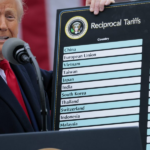The U.S. Federal Reserve is at a critical juncture as it assesses falling inflation rates, with economists highlighting the challenge of sustaining a robust economic outlook. Despite projecting a modest uptick in underlying inflation for 2024, recent trends suggest a need for caution. The Fed’s upcoming meeting will be crucial in determining whether rate cuts are warranted to address declining inflation and ensure economic stability.

As the U.S. Federal Reserve convenes for its upcoming meeting, the central bank finds itself in a pivotal moment characterized by declining inflation rates. Economic projections released after the December meeting indicated a forecasted year-end underlying inflation rate of 2.4%, with individual estimates ranging from 2.3% to 2.4%.
Economists have raised concerns about the feasibility of achieving this projection, given the current six-month trend of inflation hovering at just 1.9%. Many experts are skeptical about the likelihood of a reacceleration in inflation, particularly considering the prevailing economic conditions, which point towards a prolonged period of deceleration.
The dilemma facing central bankers is compounded by the need to reassess their interest rate projections in light of evolving inflation dynamics. While the Fed had previously indicated the possibility of three-quarters-of-a-percentage-point in interest rate cuts based on December’s outlook, the prospect of further downward revisions in inflation estimates raises questions about the timing and magnitude of future rate adjustments.
Luke Tilley, chief economist at Wilmington Trust, emphasized the discrepancy between policymakers’ optimistic outlook for inflation and the prevailing economic reality. He cautioned against overly optimistic projections, noting that the baseline expectations may be overly ambitious given the current economic climate.
The Fed’s upcoming meeting presents an opportunity for policymakers to reevaluate their stance on interest rates against the backdrop of declining inflation. While the central bank is expected to maintain rates at their current levels, the need to address falling inflation rates remains a key consideration.
Despite ending 2023 with better-than-expected inflation figures, recent trends indicate a weakening trajectory, particularly in core inflation, which has remained below 2% for seven consecutive months. Policymakers are wary of the potential implications of persistently low inflation, balancing the risk of premature rate cuts against the need to support economic stability.
The challenge for the Fed lies in deciphering whether the current inflationary pressures are transitory or indicative of broader structural changes in the economy. Factors such as labor market dynamics, government deficits, and global trade disruptions contribute to the complexity of the inflationary outlook.
Housing remains a significant concern, with policymakers closely monitoring price trends in the sector. While some anticipate a slowdown in housing inflation, other factors, such as insurance costs, continue to exert upward pressure on overall inflation metrics.
As the Fed deliberates its policy decisions, former St. Louis Fed President James Bullard advocates for a proactive approach to address falling inflation. Bullard emphasizes the importance of timely rate adjustments to mitigate the risk of economic instability, highlighting the need for effective communication to convey the rationale behind such measures.
In conclusion, the Fed faces a delicate balancing act as it navigates the challenges posed by declining inflation rates. The outcome of the upcoming meeting will provide valuable insights into the central bank’s policy direction and its response to evolving economic conditions.









